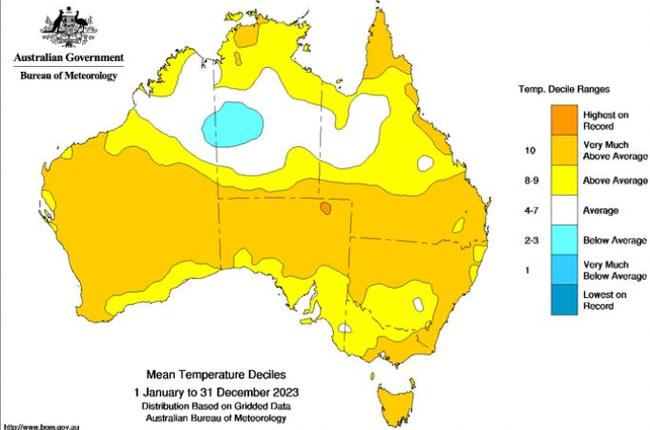BoM confirms 2023 was Australia’s eighth hottest year on record
From fatal floods to record dry spells and heat, 2023 was a year of extremes for Australia. See the map to compare temperatures by state.
Australia had its eighth-warmest year on record in 2023, but rainfall was a story of massive contrasts, with the year featuring major flooding and tropical cyclones, but also the driest national three-month period on record since 1900.
That’s the overview contained in the Bureau of Meteorology’s annual climate statement for Australia for 2023, released on Thursday morning.
The Bureau found the national average temperature for 2023 was 0.98°C above the 1961–1990 average, but it was also our warmest winter on record, with mean temperatures in that period 1.53°C above the 1961-1990 average.

Sydney had its equal second-warmest year on record, Hobart had its third warmest, Brisbane had its equal fourth warmest and Perth and Darwin had their equal fifth warmest years.
In Melbourne and Adelaide, average maximum temperatures for the year were slightly below average.
Most capital cities had dry years, with rainfall tallies in Brisbane, Hobart and Darwin all down about 25 per cent. Rainfall in Sydney was down slightly (7 per cent), Melbourne was almost exactly on average (up one per cent) and Adelaide and Canberra had wetter than average years, with tallies up 9-10 per cent.

Rainfall tended toward extremes: nationally, January and April were exceptionally wet, but the period between August and October was the driest observed since national rainfall records began in 1900. May was also extremely dry. Nationally, our annual rainfall total was up 1.6 per cent.
Despite the contrasts, surface water storages ended the year not far from where they started: in January they were at 77.9 per cent, and by the end of December they were at 74.1 per cent.
Climate Council director of research Simon Bradshaw said Australians were experiencing “climate whiplash” as they “hurtled from one extreme to another with little time to recover”.
“The stifling humidity, intense storms, soaring temperatures and other extremes of recent months are all key signs of a fast-warming planet,” he said.
While Australia had its eighth-warmest year on record, according to the Bureau, international meteorological associations put 2023 as the hottest year for the planet ever.
Ocean temperatures are a source of particular concern. The Bureau found sea surface temperatures around Australia were the seventh-warmest on record and 0.54°C above the 1961–1990 average.
Globally, the world had been seeing record warm oceans since April and record low Antarctic sea ice extent for much of the year, the Bureau said in its statement.




